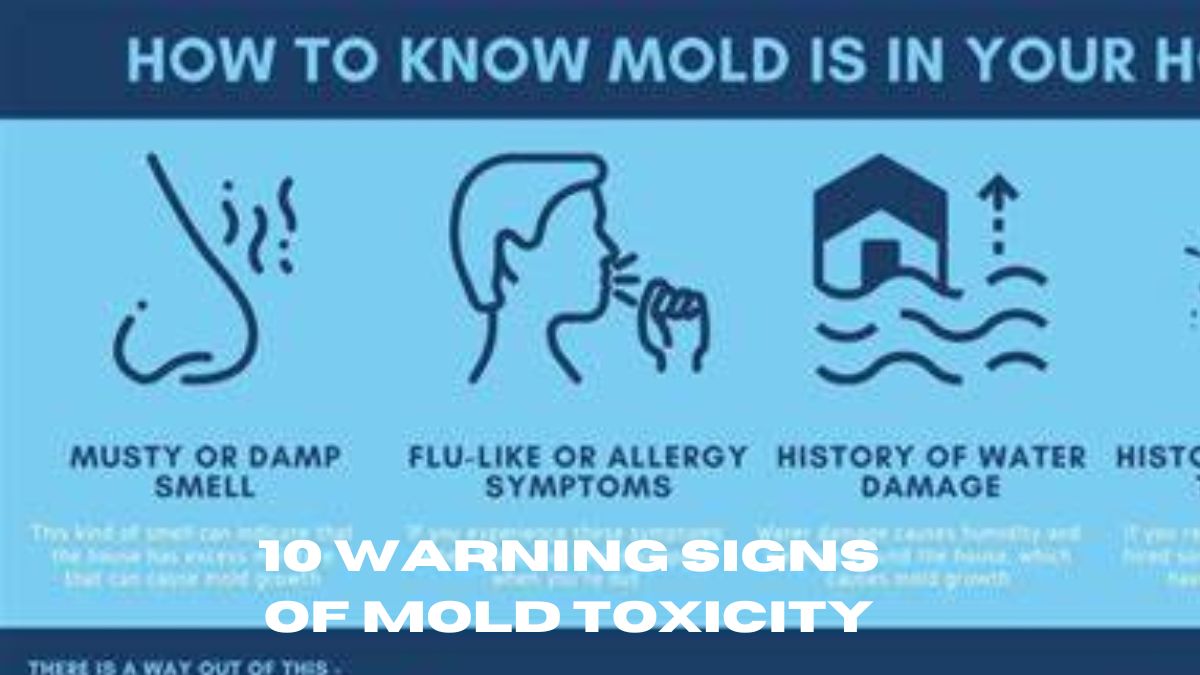HEALTH
10 Warning Signs of Mold Toxicity

Mold toxicity, also known as mold illness or mold exposure, occurs when individuals are exposed to mold and its byproducts, leading to a range of adverse health effects. Mold can grow indoors and outdoors, thriving in damp and humid environments. Recognizing the 10 Warning Signs of Mold Toxicity is crucial for protecting your health and well-being.
Introduction
Mold toxicity refers to the harmful effects that mold exposure can have on individuals. Mold is a type of fungus that can grow indoors and outdoors, and when present in high concentrations, it can release toxins known as mycotoxins. These toxins can cause a variety of health problems, ranging from mild allergic reactions to severe respiratory and neurological issues. Identifying the warning signs of mold toxicity early is essential for mitigating its impact on health.
Visible Signs of Mold
One of the most obvious signs of mold toxicity is the presence of mold growth in visible areas. Mold can appear as black, green, or white spots on walls, ceilings, and other surfaces. Additionally, a musty odor in the environment is often indicative of mold growth. If you notice mold or a musty smell in your home or workplace, it’s essential to address the issue promptly to prevent further exposure.
Physical Symptoms
Mold toxicity can manifest in various physical symptoms, including respiratory issues such as coughing, wheezing, and shortness of breath. Individuals may also experience skin irritation, rashes, and allergic reactions when exposed to mold spores. These symptoms can range from mild to severe and may worsen over time if exposure continues.
Neurological Symptoms
In addition to physical symptoms, mold toxicity can affect neurological health. Individuals exposed to mold may experience headaches, migraines, and dizziness. Cognitive impairment, memory loss, and difficulty concentrating are also common neurological symptoms associated with mold toxicity. These symptoms can significantly impact daily functioning and quality of life.
Gastrointestinal Symptoms
Mold toxicity can also affect the gastrointestinal system, leading to digestive problems such as nausea, vomiting, diarrhea, and abdominal pain. These symptoms may occur shortly after exposure to mold or may develop over time with continued exposure. Individuals with pre-existing gastrointestinal conditions may be particularly susceptible to the effects of mold toxicity.
Fatigue and Weakness
Feeling tired and lethargic despite adequate rest is another common symptom of mold toxicity. Mold exposure can drain the body’s energy reserves, leading to fatigue, weakness, and malaise. Additionally, individuals may experience muscle weakness, joint pain, and general feelings of unwellness.
Sensitivity to Light and Sound
Some individuals with mold toxicity may experience increased sensitivity to light (photophobia) and sound (phonophobia). Bright lights and loud noises can exacerbate symptoms such as headaches, dizziness, and irritability. Managing environmental stimuli and reducing exposure to triggers can help alleviate these symptoms.
Changes in Mood
Mold toxicity can impact mood and emotional well-being, leading to symptoms such as anxiety, depression, and irritability. Mood swings, agitation, and feelings of hopelessness may also occur. These psychological symptoms can be particularly challenging to cope with and may require professional intervention.
Chronic Sinus Infections
Frequent sinus congestion, nasal congestion, and sinus infections are common among individuals exposed to mold. Mold spores can irritate the nasal passages and sinuses, leading to inflammation and infection. Persistent sinus pressure, headaches, and facial pain may indicate chronic sinus issues related to mold toxicity.
Worsening of Asthma
For individuals with asthma, mold exposure can exacerbate existing respiratory symptoms and lead to asthma attacks. Wheezing, coughing, chest tightness, and difficulty breathing may worsen in environments with high mold concentrations. Proper management of asthma and avoidance of mold exposure are essential for preventing complications.
Conclusion
Recognizing 10 Warning Signs of Mold Toxicity is crucial for protecting your health and well-being. If you experience any of the symptoms mentioned above, especially in conjunction with mold exposure, it’s essential to seek medical attention promptly. Additionally, taking steps to prevent mold growth in your home or workplace can help reduce the risk of mold-related health problems.
HEALTH
Why Hospice Care Nutritional Counseling is Essential for Chronic Disease Management

Managing chronic diseases can be incredibly overwhelming, and with the rising incidence of illnesses such as diabetes, cardiovascular diseases, and obesity, the need for effective management strategies has never been greater. One particularly valuable strategy is nutritional counseling. But what exactly is nutritional counseling, and why is it so crucial in managing chronic diseases? Additionally, how does hospice care integrate with these strategies to provide comprehensive support for those with terminal illnesses? Let us delve into this important topic and explore the numerous benefits nutritional counseling and hospice care offer in chronic disease management and end-of-life care.
What is Nutritional Counseling in Hospice Care?

Nutritional counseling in hospice care is a process that involves the dissemination of personalized information about diet and lifestyle by a qualified health professional. Its objective is to advise clients properly on the choice of food and the development of proper eating habits for the maintenance of good health. This typically includes credentialed assessment of one’s dietary level of intake, establishment of nutritional deficiencies if they exist, and formulation of a personalized or customized nutrition plan for optimum satisfaction of stated objectives.
The Role of Nutrition in Managing Chronic Disease
These are chronic diseases that cannot permanently be cured but can be controlled for an extended period of time, like diabetes, heart disease, and obesity. Therefore, the relationship between nutrition and health may play a leading role. For example, a balanced diet controls the sugar level in the blood in diabetes, regulates blood pressure in hypertension, and helps weight reduction in obesity. Consequently, the relation between the food we intake and the results associated with our health cannot be over-emphasized.
Benefits of Nutritional Counseling for Chronic Disease Management
- Improved Outcomes of Diseases: A proper diet may significantly improve disease markers, such as blood sugar levels, cholesterol, and blood pressure. With a personal diet plan, patients can progress further in managing their conditions better, which may reduce their dependence on medications.
- Better Quality of Life: Most chronic diseases have certain symptoms that hamper quality of life. With the right consultations, people can help themselves reduce these symptoms, enhance energy, improve mood, and promote a better sense of well-being in general.
- Personalized Dietary Plans: While broad dietary advice is generic, nutritional counseling gives personalized prescriptions respecting an individual’s status, tastes, and preferences regarding health and lifestyle, which has relatively better adherence and guarantees long-term success.
Common Chronic Diseases Related to Unhealthy Diet
Diabetes
Maintaining carbohydrate intake is critical for diabetes. Nutritional counselors help design meal plans that maintain stable blood sugar levels, diminish complications, and promote total good health.
Cardiovascular Disease
Dietary changes can have an incredible impact on heart health. Nutritional counseling aims to lower saturated fats and increase fiber consumption, particularly in foods recommended for heart health.
Obesity
Weight management is a large component of treating obesity. A nutritional counselor provides goals for a balanced diet, portion size, and even behavioral modification during the process of losing and maintaining weight.
Cancer
Nutrition is key to any cancer patient undergoing treatment and recuperating from illness. Good nutrition counseling will ensure appropriate nutrient intake, strengthen patients with treatment effects, enhance strength, and boost immunity.

Evidence-Based Nutrition
Basically, evidence-based nutrition is about making dietary recommendations and decisions based on the best scientific evidence available. Imagine it this way – instead of totally guessing what is healthy or doing what the latest diet fad advises you to do, evidence-based nutrition would have solid research and data to figure out what foods and dietary patterns are truly good for our health.
Think of it as doing your homework before making a decision. You wouldn’t buy a car if you didn’t read reviews or check its safety ratings; evidence-based nutrition requires studying, conducting clinical trials, and studying nutritional science to understand how different foods affect our bodies.
Evidence-Based Nutrition May Include:
Scientific Research: The groundwork is radical scientific research, including a review of large-scale research, randomized controlled trials, and meta-analyses that combine the findings of numerous studies to provide clear evidence on how nutrition affects health.
Reliable sources: It relies on information from sources like peer-reviewed journals, research institutions, and health organizations.
Continuous Learning: Nutrition science is constantly evolving, and what we understand as healthful eating may immediately change based on emerging research. Evidence-based nutritionists are current with new research and update their recommendations accordingly.
Individualized Approach: Although general principles are somewhat useful, evidence-based nutrition considers individual variability. Variables such as age differences, sex, health conditions, and lifestyle can throw you off what is best for a person.
Practical Application: It’s not all about science but how to apply it in real life. Evidence-based nutrition takes these complicated research studies and gives them back to people in the form of practical tips and advice that can be followed to attain better health.
For example, high consumption of fruits, vegetables, whole grains, lean proteins, healthy fats, and other vegetables decreases the risk of emerging chronic diseases, such as heart disease and diabetes. Therefore, health professionals use findings like these as the foundation for dietary guidelines.
To sum up, evidence-based nutrition simply means using the best science available to guide our food choices so that we eat in ways that are most supportive of health and well-being. Think of it as a roadmap with good directions that help us navigate this oft-confusing field of nutrition.
Nutritional Counseling Process
- Initial Assessment: The counselor evaluates the client’s current diet, health status, and nutritional needs.
- Realistic Goal Setting: Realistic, specific, and measurable health goals are set by the counselor and client together.
- Follow-up and Funing: Appropriate and continuous support and fine-tuning of the nutrition plan are essential for achieving long-term success and compliance.
Nutrition Education
The counseling process empowers clients with information on diet, food, and nutrition. They learn how to read food labels, portion sizes, and healthful food choices that contribute to a healthy diet. This education teaches independence and self-assurance related to dietary intake and health status.
Nutritional Counseling vs. General Dietary Advice
General dietary advice is like the broad strokes of one’s painting. These are the very simple basic guidelines one usually has had and still hears about eating healthy, such as “eat more fruits and vegetables,” “choose whole grains,” or “limit your sugar intake.” This advice is good for getting on the road toward health and is normally, by general rules, good for most people.
Widespread dietary advice, however, remains kind of general. It is totally blind to what you need, what you like, and what makes you sick. It’s like a one-size-fits-all T-shirt size – it’ll fit many reasonably well, but maybe not you the best.
Nutritional counseling, however, is very individualized and specific. Think of getting a custom-tailored suit instead of that one-size-fits-all T-shirt. In nutritional counseling, a qualified health professional – one with whom you would meet privately, usually a registered dietitian – drafts a kind of nutrition plan personally tailored for you.
Here’s what sets nutritional counseling apart:
Personalized Plans and Goals: Nutritional counselors consider your health history, current health status, way of life, and personal taste. They will then create a personal plan tailored to your needs and help you stick with it.
Be it managing a lifelong chronic disease like diabetes, seeking weight loss, or looking and feeling better, nutrient counseling delivers concrete ways to achieve your objectives. This is not about eating healthily but about doing so in the most effective way possible.
Follow-up and Support: Much of nutrition counseling involves follow-up after an initial session. By having regular meetings with their counselor, most people are able to keep moving on the chosen path, make adjustments as needed, and overcome any kind of challenging situation. This continuous support is what really makes all the difference.
Education and Empowerment: It educates you so that qualified dietary counselors empower you to make better choices. You are trained to read food labels, understand portion sizes, and even make decent nutritional choices when eating out.
Evidence-Based Approach: As we have discussed in evidence-based nutrition, it would be deeply based on the latest scientific research. This would further identify the correctness and reliability of any advice you might seek.
Holistic View: Nutritional counseling broadens the vision and considers stress, sleep, and physical activity—all those other things that ultimately find a place in the big picture of health. It is, therefore, more holistic in approach than mere dietary advice, which any person can easily follow.
In a nutshell:
General dietary advice is good for anyone who is trying to improve their diet. It provides the basics of healthy eating. However, if you have certain health issues or unique dietary needs, or if you just want more personalized advice, then nutritional counseling is in your best interest. It is individual, supportive, and need-based—hence, a much more powerful tool for achieving your health goals.
How to Find a Qualified Nutritional Counselor

When seeking a nutrition counselor, look for the credentials RD (Registered Dietitian) or CNS (Certified Nutrition Specialist). Ask about your experience in managing chronic diseases and the approach to individualizing your nutrition plan.
Integrating Nutritional Counseling into Health Care
Effective chronic disease management often requires a team approach. Nutritional counselors in Hospice care work alongside physicians, nurses, hospice care providers, and other health professionals. This kind of interdisciplinary approach helps foster excellence in patient care and offers holistic health support.
Nutritional counseling is one of the most essential services in managing chronic diseases. Nutritional counselors provide evidence-based dietary advice tailored to the individual, promoting better health and improved quality of life. In the context of hospice care, nutritional counselors play a vital role in ensuring patients receive appropriate nutritional support, enhancing their comfort and well-being during end-of-life care. This collaborative effort between different health professionals ensures that patients receive comprehensive and compassionate care throughout their journey.
HEALTH
How Can CBD Oil Help with Dogs Anxiety: A Science Based Overview

If you’re reading this, your dog probably struggles with anxiety. And let’s face it, an anxious dog is a difficult one to handle. Whether it’s separation anxiety, fear of loud noises (thanks, fireworks), or just an overall sense of unease, watching your pup suffer can make you feel pretty helpless. If that’s the case, CBD oil might be the secret weapon you’ve been searching for.
CBD has been showing some serious potential when it comes to calming dogs with anxiety. But before you start shopping for CBD oil for your dog, let’s walk through everything you need to know: what CBD is, how it can help, and how to use it effectively. Consider this your comprehensive guide to all things CBD for dog anxiety!
What Is CBD Oil Anyway?
Think of CBD oil as a chill pill for your dog—except it’s all-natural and non-psychoactive. CBD (cannabidiol) is a compound found in cannabis plants, including hemp. Unlike its flashy cousin THC (the compound in marijuana that gets you “high”), CBD won’t leave your dog thinking it’s time for a psychedelic trip. It’s all relaxation, no paranoia.
Most CBD oils used for pets are extracted from hemp, which contains less than 0.3% THC. That’s super important because it means CBD is safe for your dog—no wild rides, just sweet, sweet relief.
But Wait, Isn’t Hemp Oil the Same as CBD Oil?
Nope! This is a common mix-up, so let’s clear it up. Hemp oil comes from pressed hemp seeds, which are full of nutritional goodness (think Omega-3s) but don’t contain CBD. CBD oil, on the other hand, is extracted from the entire hemp plant, where all the beneficial CBD is hiding out. So, if you’re looking to tackle anxiety, you need CBD oil, not just hemp oil.
How CBD Works Its Magic for Dog Anxiety
CBD works by interacting with your dog’s endocannabinoid system (ECS)—a fancy term for a network of receptors that helps regulate things like mood, pain, sleep, and immune responses. Yep, your dog has one of these systems too! When CBD comes into play, it helps the ECS do its job better, which can mean a calmer, happier, less anxious dog.
Dogs suffering from anxiety—whether it’s triggered by loud noises, separation, or that terrifying vacuum cleaner—can often find relief with CBD. It’s like flipping a switch in their brain, turning down the dial on those anxious feelings.
The Big Benefits of CBD for Dog Anxiety
Here’s the fun part: CBD isn’t just good for calming anxiety. It comes with a whole spectrum of benefits for your dog’s overall health. Let’s take a closer look at what CBD oil can do:
1. Calm That Anxiety
Whether your pup is freaking out over thunderstorms or hates being left alone, CBD can help. It works on multiple types of anxiety, including:
- Separation anxiety: You leave, they lose it. CBD helps keep them calm.
- Fear of loud noises: Fireworks, thunder, vacuum cleaners—whatever the trigger, CBD can take the edge off.
- Travel anxiety: Car rides? Planes? New places? No problem with a little CBD.
- General nervousness: Some dogs are just naturally anxious. CBD gives them a much-needed chill pill.
2. Pain and Joint Relief
Does your dog suffer from joint pain? CBD’s anti-inflammatory properties can offer some serious relief, especially for dogs dealing with arthritis or joint issues. It’s also great for neuropathic pain, a type of chronic pain that’s tough to manage otherwise.
3. Seizure Control
Studies have shown CBD may reduce the frequency of seizures in dogs with epilepsy. It’s not just for anxiety, but can also help dogs with more serious conditions like this one.
4. Better Sleep
CBD’s calming effect isn’t just for waking hours. If your dog’s anxiety keeps them up at night (and you too), CBD might promote better, more restful sleep.
5. Anti-Inflammatory Power
CBD doesn’t just help with anxiety and pain; it also fights inflammation. That’s good news for dogs with inflammatory conditions, whether it’s from joint issues or something else entirely.
Real-Life Success Stories: CBD Oil for Anxious Dogs
Alright, let’s talk examples. Meet youtuber Chessa Kali and her rescue dog, Bennie, who struggled with severe anxiety and nightmares. His owner tried everything, from training to environmental changes, but Bennie was still anxious and suffering. After trying CBD oil, Bennie showed a noticeable improvement in his demeanor. He was calmer, slept better, and even started enjoying car rides.
Bennie’s story isn’t unique—there are countless anecdotes from dog owners who swear by CBD oil as a game-changer for their pup’s anxiety.
Potential Side Effects: What You Need to Know
Like with any product, it’s important to weigh the benefits against the risks. The good news? CBD is generally considered safe for dogs. However, a few mild side effects could pop up, especially if you go heavy on the dosage. Here’s what to watch for:
- Dry mouth: Your dog might get extra thirsty after taking CBD. Keep that water bowl filled!
- Lowered blood pressure: High doses of CBD can cause a temporary drop in blood pressure. This might make your dog a little lightheaded or sleepy.
- Drowsiness: CBD’s calming effect could be a little too effective at higher doses, making your dog extra sleepy.
It’s always a good idea to consult your veterinarian before starting any new treatment, especially if your dog is on other medications. CBD can interact with certain medications by affecting liver enzymes that break down those drugs, so be cautious and keep your vet in the loop.
Picking the Right CBD Product for Your Dog
Not all CBD is created equal, so when you’re looking for the best CBD products for your dog’s anxiety, make sure you’re picking high-quality stuff. Here’s what to look for:
1. Full Spectrum vs. Isolate
You’ll see terms like full spectrum CBD and CBD isolate thrown around. Full spectrum means the product contains all the beneficial compounds from the hemp plant (not just CBD), while isolate is pure CBD. Full spectrum products are often recommended because they offer an “entourage effect”—meaning the compounds work together for maximum benefit. It’s like a full band playing in harmony versus a solo act.
2. Organic Hemp
Choose CBD oils made from organically grown hemp. You don’t want any pesticides, herbicides, or heavy metals in your dog’s calming oil, right?
3. Third-Party Lab Testing
Always go for products that are third-party lab tested. This ensures the product’s quality, potency, and safety. Look for a Certificate of Analysis (COA) to make sure what’s on the label is actually in the bottle.
4. CBD Concentration
Not all dogs need the same strength of CBD. The concentration of CBD in the oil is key. Make sure you get a product suited to your dog’s size and level of anxiety.
Forms of CBD for Dogs: What’s Best?
CBD for dogs comes in different forms, each with its own pros and cons. Here’s the breakdown:
1. CBD Oils and Tinctures
These come with a dropper for easy dosing, allowing you to fine-tune the dosage. If your dog doesn’t mind you popping the oil under their tongue (hello, faster absorption), this is a solid choice.
2. CBD Chews
These are pre-dosed, tasty treats that make giving CBD as easy as saying “sit!” CBD chews are perfect for pups who won’t take oil straight but might be pricier if you’ve got a big dog or need long-term use.
3. Capsules
If your dog takes pills like a champ, CBD capsules offer a pre-measured dose with no fuss. Just pop one in their food and call it a day.
4. Topicals
For localized issues like joint pain or inflammation, CBD-infused balms and salves can be applied directly to the skin. These are great for targeting specific areas.
How to Give CBD to Your Dog
When it comes to CBD, start low and go slow. Here’s a simple guide:
Dosage by Weight: A good rule of thumb is 1-5 mg of CBD per 10 pounds of body weight. For a 50-pound dog, you’d start with around 5-10 mg.
Start Small: Begin with the lowest recommended dose and see how your dog reacts. If needed, you can gradually increase it.
You can give your dog CBD in several ways:
- Directly into their mouth (using the dropper for quick absorption)
- Mixed in with their food or a favorite treat
- Topically on affected areas if dealing with joint pain or inflammation
Always Talk to Your Vet First
Before diving headfirst into the world of CBD products, have a chat with your vet. They’ll help determine if CBD is a good fit for your dog, especially if your pup’s on other meds or has underlying health issues.
Your vet can also guide you on dosage, help you choose a reputable product, and keep an eye out for any side effects. Teamwork makes the dream work, after all.
Other Ways to Calm Your Anxious Dog
While CBD chews and oils are awesome, they’re not the only trick in the book. Here are a few other options that might help your anxious dog:
- Behavioral training: A professional trainer can help tackle underlying anxiety issues.
- Environmental changes: Create a safe space with comforting items like a bed or blanket.
- Prescription meds: In severe cases, your vet may prescribe medication like Trazodone.
The Takeaway: CBD Could Be the Relief Your Dog Needs
If your dog is constantly anxious, CBD might just be the game-changer you’ve been waiting for. From reducing anxiety to easing joint pain and improving sleep, the benefits of CBD oil are pretty impressive.
But remember, not all CBD products are created equal. Look for high-quality, full spectrum CBD oils, and always chat with your vet before starting something new. And if you’re ready to try CBD for your dog, start low, go slow, and watch the transformation happen!
HEALTH
Maximizing Productivity After Dark: The Benefits of the Keto Diet for Night Shift Workers

Working the night shift poses significant challenges for many individuals. The disruption to the body’s natural circadian rhythm can lead to various health issues, including sleep disturbances, fatigue, and decreased productivity. Night shift workers often struggle to maintain focus and alertness during their shifts, resulting in decreased job performance and overall well-being.
Furthermore, the limited access to healthy food options during the night can make it difficult for night shift workers to maintain a balanced diet, exacerbating their health and productivity challenges. One of the primary challenges of working the night shift is its impact on sleep patterns. The body’s natural circadian rhythm is designed to align with the sun’s rising and setting, so when individuals work at night, it can disrupt their internal clock.
This disruption can lead to difficulty falling asleep during the day and staying awake and alert at night, resulting in decreased productivity and overall well-being. The limited access to healthy food options during the night can further complicate the challenges faced by night shift workers, making it difficult for them to find a diet that supports their unique needs and maximizes their productivity during night shifts.
Key Takeaways
- Night shift work can pose challenges to productivity and overall well-being.
- The keto diet can support night shift workers by providing sustained energy levels and improved cognitive function.
- Ketosis, a state achieved through the keto diet, can enhance energy levels and mental clarity.
- Meal planning and preparation are essential for success on the keto diet during night shifts.
- Many night shift workers have found success and improved productivity by following the keto diet.
The Impact of Diet on Night Shift Worker Productivity
The Struggle for Healthy Food Options
Many night shift workers struggle to find healthy food options during their shifts, often relying on fast food or vending machine snacks. This can lead to weight gain, fatigue, and other health issues that affect job performance and quality of life. A keto food list tailored to the unique needs of night shift workers can provide solutions by emphasizing high-fat, low-carb options that maintain energy and mental sharpness.
Metabolic Challenges of Night Shift Work
In addition to the challenges of finding healthy food options, night shift workers also face unique metabolic challenges that can impact their productivity. Research has shown that working at night can disrupt the body’s natural metabolic processes, leading to increased insulin resistance, weight gain, and other metabolic issues.
Maximizing Productivity with a Supportive Diet
It’s clear that finding a diet that supports the unique needs of night shift workers is crucial for maximizing productivity after dark. By understanding the challenges of night shift work and making informed dietary choices, night shift workers can maintain their energy levels, support their overall health, and perform at their best.
How the Keto Diet Can Support Night Shift Workers
The ketogenic diet, or keto diet, has gained popularity in recent years for its ability to support weight loss, improve energy levels, and enhance overall well-being. This high-fat, low-carbohydrate diet is designed to put the body into a state of ketosis, where it burns fat for fuel instead of carbohydrates. This can lead to increased energy levels, improved mental clarity, and better overall health – all of which are crucial for night shift workers looking to maximize their productivity after dark.
One of the key benefits of the keto diet for night shift workers is its ability to provide sustained energy levels throughout the night. By reducing carbohydrate intake and increasing fat consumption, the keto diet helps stabilize blood sugar levels and prevent energy crashes that are common during the night. This can help night shift workers stay alert and focused during their shifts, leading to improved job performance and overall well-being.
Additionally, the keto diet has been shown to support weight loss and improve metabolic health, which can help mitigate some of the metabolic challenges associated with working at night.
The Science Behind Ketosis and Energy Levels
| Benefits of Keto Diet for Night Shift Workers | Metrics |
| Improved Energy Levels | Increased alertness and focus during night shifts |
| Enhanced Mental Clarity | Improved cognitive function and decision-making |
| Stable Blood Sugar Levels | Reduced risk of energy crashes and fatigue |
| Weight Management | Effective weight control and reduced risk of obesity-related health issues |
| Improved Sleep Quality | Enhanced ability to fall asleep and stay asleep during the day |
The science behind ketosis and its impact on energy levels is well-documented. When the body is in a state of ketosis, it produces ketones as a byproduct of burning fat for fuel. These ketones serve as an alternative energy source for the brain and body, providing a steady supply of fuel that can help prevent energy crashes and fatigue.
This is particularly beneficial for night shift workers, who often struggle to maintain energy levels throughout their shifts. In addition to providing sustained energy levels, ketosis has also been shown to improve mental clarity and cognitive function. Research has demonstrated that ketones can provide a more efficient source of fuel for the brain, leading to improved focus, concentration, and overall cognitive function.
This can be incredibly beneficial for night shift workers who need to stay alert and focused during their shifts. By supporting sustained energy levels and improved cognitive function, the keto diet can help night shift workers maximize their productivity after dark.
Meal Planning and Preparation for Night Shift Success
Meal planning and preparation are crucial for success on the keto diet, especially for night shift workers. Planning ahead and preparing meals in advance can help ensure that night shift workers have access to healthy, keto-friendly options during their shifts. This can help prevent reliance on unhealthy fast food or vending machine snacks, which can lead to weight gain and decreased productivity.
When meal planning for night shift success on the keto diet, it’s important to focus on high-fat, low-carbohydrate options that provide sustained energy levels throughout the night. This may include foods such as avocados, nuts, seeds, fatty fish, and low-carb vegetables. Additionally, it’s important to stay hydrated and consume plenty of water throughout the night to support overall well-being and energy levels.
By taking the time to plan and prepare keto-friendly meals and snacks, night shift workers can set themselves up for success and maximize their productivity after dark.
Managing Sleep and Energy Levels with the Keto Diet
Managing Sleep and Energy on the Keto Diet as a Night Shift Worker
Improved Sleep Quality
In addition to meal planning and preparation, managing sleep and energy levels is crucial for success on the keto diet as a night shift worker. The keto diet has been shown to support improved sleep quality and duration, which can be incredibly beneficial for individuals working at night. By stabilizing blood sugar levels and promoting relaxation, the keto diet can help night shift workers get better quality sleep during the day, leading to improved energy levels and overall well-being. For advice on sleep hygiene and managing sleep disorders, check out resources from MedlinePlus.
Preventing Energy Crashes
In addition to supporting improved sleep quality, the keto diet also helps prevent energy crashes and fatigue during the night. By providing sustained energy levels through ketosis, the keto diet can help night shift workers stay alert and focused throughout their shifts. This can lead to improved job performance and overall well-being.
Maximizing Productivity
By managing sleep and energy levels with the keto diet, night shift workers can maximize their productivity after dark.
FAQs
What is the keto diet?
The keto diet is a high-fat, low-carbohydrate eating plan that has been shown to help the body burn fat for energy, leading to weight loss and other health benefits.
How does the keto diet benefit night shift workers?
The keto diet can benefit night shift workers by providing sustained energy levels, improved mental clarity, and better sleep quality during the day, which can help maximize productivity during nighttime hours.
What are some key foods to eat on the keto diet for night shift workers?
Key foods to eat on the keto diet for night shift workers include healthy fats such as avocados, nuts, seeds, and olive oil, as well as low-carbohydrate vegetables, lean proteins, and dairy products.
Are there any potential drawbacks to the keto diet for night shift workers?
Some potential drawbacks of the keto diet for night shift workers may include the need for careful meal planning and preparation, as well as potential initial side effects such as the “keto flu” as the body adjusts to using fat for fuel instead of carbohydrates.
Is the keto diet safe for night shift workers with certain health conditions?
It is important for night shift workers with certain health conditions, such as diabetes or heart disease, to consult with a healthcare professional before starting the keto diet, as it may not be suitable for everyone.

 Cartoon8 months ago
Cartoon8 months agoUnlocking the Potential of Nekopoi.care: A Comprehensive Guide

 Game7 months ago
Game7 months agoExploring Aopickleballthietke.com: Your Ultimate Pickleball Destination

 BUSINESS7 months ago
BUSINESS7 months agoWhat Companies Are In The Consumer Services Field

 TECHNOLOGY6 months ago
TECHNOLOGY6 months agoThe Guide to Using Anon Vault for Secure Data Storage

 ENTERTAINMENT8 months ago
ENTERTAINMENT8 months agoThe Epic Return: Revenge of the Iron-Blooded Sword Hound

 HEALTH8 months ago
HEALTH8 months agoUnveiling the Mystery of Pikruos: A Comprehensive Guide

 HOME IMPROVEMENT8 months ago
HOME IMPROVEMENT8 months agoVtrahe vs. Other Platforms: Which One Reigns Supreme?

 HOME IMPROVEMENT8 months ago
HOME IMPROVEMENT8 months agoExploring the Events of 2023-1954: A Look Back in Time
















